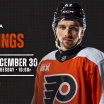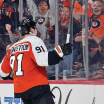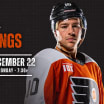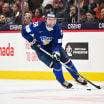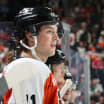Less than a week after acquiring Ryan Ellis to serve as the right-side partner to Ivan Provorov on their top pairing, and one day after trading Shayne Gostisbehere and two draft picks (2022 second-round pick and 2022 seventh-round selection) to the Arizona Coyotes for $4.5 million of cap relief, the Flyers made a very bold trade.
Instant Analysis: Flyers Trade for Ristolainen
The team sent its 2021 first-round NHL Draft pick, defenseman Robert Hägg and a 2023 second-round pick to Buffalo for 26-year-old defenseman Rasmus Ristolainen

By
Philadelphia Flyers
philadelphiaflyers.com
The team sent its 2021 first-round NHL Draft pick (the de facto 13th overall selection), NHL roster defenseman Robert Hägg and a 2023 second-round pick to the Buffalo Sabres for 26-year-old defenseman Rasmus Ristolainen.
Ristolainen, who is entering the final season of his $5.4 million AAV contract and is a potential unrestricted free agent in the summer of 2022, is slated to step in on the Flyers second defense pairing as the right-side partner for Travis Sanheim. The Flyers now have a left/right shot balance on every pair (Provorov with Ellis, Sanheim with Ristolainen, and perhaps rookie Cam York with Justin Braun).
The trade price was steep. Buffalo demanded a first round pick as the ante non-negotiable part of any trade for Ristolainen, and seven teams were willing to do so. Additionally, Ristolainen is a polarizing player. Most NHL pro scouts and other "hockey people" have long been advocates for the Finnish defenseman's physical abilities. Most opponents detest playing against him. The analytics community, on the other hand, is almost unanimously critical of the player because his underlying numbers have annually been poor.
First, here are the positives, beyond being a right-handed defenseman (who are perpetually in short supply and high demand).
Ristolainen is huge (6-foot-4, 220 pounds) and a conditioning fanatic ala Provorov. He can absorb as many minutes as his coach asks without tiring. Ristolainen has very fast recovery times between shifts.
Despite his big frame, Ristolainen is quite mobile. That is a coveted combination. He's also been durable. His severe bout with COVID-19 earlier this year represented his longest absence from the lineup in his career. Otherwise, he rarely misses games.
Ristolainen plays with snarl and physicality. He is third among all NHL defensemen in hits over the last five seasons. He also ranked third in hits at his position during the 2020-21 campaign.
Lastly, Ristolainen is good on the power play. He has posted 40-plus points in four different NHL seasons.
"I would say I'm a player that other teams hate to play against, and I try to be a pain in the ass. I can do everything, penalty kill, power play. I can pass the puck. I can shoot the puck. I can play any type of role. Hard worker. I like to hit. Just do anything it takes to win."
The likely usage plan in Philadelphia is that Provorov and Ellis will be tasked with doing the heaviest lifting in the toughest matchups in the majority of games. Sanheim and Ristolainen will also see a lot of minutes, but the aim is to get Ristolainen a less skewed zone-start differential at 5-on-5 than he had in Buffalo. Third pairing staple Braun will still be part of a penalty killing rotation, and can move up periodically as needed to play with Sanheim. The 20-year-old York, if he makes the team out of camp, will get some power play time on top of third-pair minutes.
The drawbacks with Ristolainen primarily lie in his career analytics. Throughout his NHL career to date. Finn has posted poor numbers in a variety of commonly tracked analytics (shot attempt differentials. scoring chance differentials,on/off ice relative numbers). He's also had rough traditional plus-minus numbers annually.
Context is needed. Ristolainen, who was selected by Buffalo with the eighth overall pick of the 2013 Draft, was thrust into the NHL on a perennially struggling Sabres team that is currently undergoing another rebuilding project. A big part of the team's problem has been putting too much on the plate of its youngest players before they've developed sufficiently to effectively handle the most demanding responsibilities. The team has annually selected at or near the top of the NHL Entry Draft, chosen highly regarded prospects, but remained at or near the bottom of the NHL standings. Even for those who developed as projected, there was an insufficient supporting cast and a revolving door of coaches and linemates.
In Ristolainen's case, after being selected eighth overall in 2013, he was almost immediately asked to play a shutdown role against NHL opponents' No. 1 lines. He's largely stayed in that role. At 5-on-5, he has started the decided majority of his career 5-on-5 shifts in the defensive zone: 54.3 percent for his career overall, and 58.7 percent in 2020-21. To put it bluntly, the player was largely put in position to fail because the Sabres had little other choice. So far in the early career of 21-year-old Sabres defenseman Rasmus Dahlin, who was selected first overall in the 2018 Draft and hailed as a franchise defenseman, it's been a similar sort of struggle trying to be a blueline savior on a struggling team. Dahlin has posted 40-plus points in two of his three seasons but the Sabres have also hemorrhaged goals in the same fashion they did when Ristolainen was prematurely installed as their No. 1 defenseman.
"Rasmus is a young man that stepped into Buffalo and played a really big role at a young age on a developing hockey team. He had five different head coaches in Buffalo, so AV will be his sixth head coach. We're hoping that with stability and putting him with an experienced partner, another good young player, that he can come in and fit in very nicely with our group. He can shoot the puck. He can skate. He's big and strong. I think when you look at our defense corps now, we have a pretty good mix of youth and veteran players. We have guys that can play on the power play and on the penalty kill. We have size and, obviously with Ellis, we added a lot of experience to go with Justin Braun. I think our group, the pieces fit well together and the strength of any one defenseman is often dependent upon the strength of the group. I think all of these guys can complement each other and help each other grow their game," Fletcher said.
Ristolainen said that he doesn't absolve himself of accountability for the Sabres' ongoing struggles during his years in Buffalo. He is happy to turn the page.
"Obviously, we had really, really tough years in Buffalo. I played a big part. I was one of the leaders there and we couldn't make the playoffs. That's not good. Obviously, when that's the case, you get to make some moves and players get traded. I'm very excited to go to Philadelphia and I'm going to do anything I can to help the team make the playoffs and have a run there. All I care is to win and I don't care what my role will be," he said.
The other concern about Ristolainen's acquisition, especially given the high premium paid to acquire him, is whether he will sign a contract extension or opt to test unrestricted free agency in the summer of 2022.
"Looking at the pieces, I like the team a lot. I think it'll be a good fit for me. Obviously, getting the [trade] call an hour, 90 minutes ago, I haven't thought about anything else. Trying to answer texts and calls and figuring out things. I haven't thought about the extension, but obviously, everything is possible. We'll see what happens in the future," Ristolainen said.
Fletcher, for his part, said that negotiations for a contract extension are not imminent. However,he acquired Ristolainen with the belief that the player can be a Flyer for a long time and not just a one-year rental.
"Certainly, we look at Ristolainen as being a guy that should have a very good chance of being part of our future going forward. That's something we'll look at in due course. Depending on the cap and where we're at, we'll look to do things when the timing is right," Fletcher said.
For 2021-22, the differential between Ristolainen's incoming cap hit and Hägg's outgoing AAV is $3.8 million. That leaves the Flyers with a maximum of $10.085 million to spend this season, which includes re-signing restricted free agents Carter Hart and Travis Sanheim as well as acquiring a second goaltender to share the net with Hart. Fletcher also indicated that he's still interested in adding a two-way forward who can help the Flyers improve on the penalty kill. The team may need to create some additional cap space if the latter is to come to fruition.
Fletcher was complementary of Hägg, both as a physical defenseman and as a human being off the ice.
"I had a really nice conversation with him today. I think for Robert, I'll let him speak later on whenever he speaks in Buffalo. This is a contract year for him, and there may have been a little bit of uncertainty as to what his role would have been with this club this year. It allowed us to make the cap work. I think for him, it gives him an opportunity to hopefully play more minutes in a very important year for his career. He was a heart and soul guy. He blocked shots. He killed penalties. He was a very popular teammate and somebody that earned the respect of everybody in the organization. Certainly, I want to thank Robert for his time here and for his contributions. I hope he has a great season in Buffalo and is able to come up with a nice contract going forward," Fletcher said.

